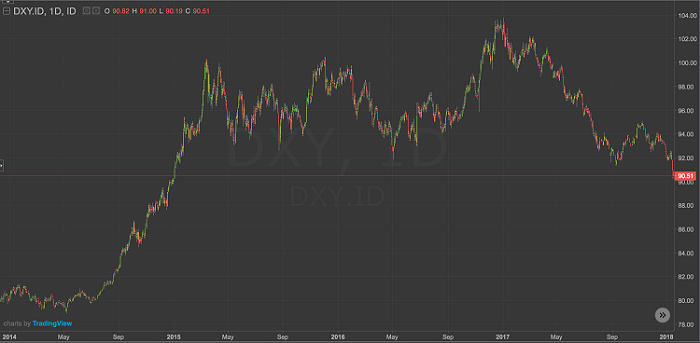Monday Market Watch
It will be a short trading week with Australia Day on Friday, and it's also a very light week for data from Australia and Asia for that matter.
The only notable piece from the region is Westpac's leading index, which is a collation of several components that includes things like the local market, dwelling approvals, US industrial production, the commodities price index as well as the yield spread of the 10-year to 90-day bank bill swap rate (BBSW).
It's been in expansion for the past three months, and considering the movements in markets in December this should see a fourth month of expansion. The index is an interesting overview of the state of markets and the economy, but nothing more.
This means that for our macro fix this week it's the US and Europe that will fill the gap, and there is certainly plenty to discuss with the ECB's first meeting of 2018 and the US releasing its fourth quarter GDP. Although only a preliminary read, all the signs are pointing to a solid finish to the year in the US.
However, the lead0in point to the data this week and why it is important on a global and Australian-centric point of view is the current trade of the US dollar basket or DXY.

(Source: IRESS)
The US dollar currently is under enormous pressure – DXY hasn't been this low since 2014, as several factors feed into its weakness:
- The return to growth in other economies;
- The decreasing probabilities of continual rate rises in the US versus the increased probability of rate rises by other central banks;
- The current US bond market rout (which is clearly draining US dollar demand).
However, the real drivers of the DXY have been the EUR (euro) and JPY (Japanese yen), both of which have been appreciating heavily in the past six to eight weeks – the JPY due to increased risks in the US bond market.
The EUR, however, is a more interesting story. Two weeks ago, the minutes from the December ECB meeting were released, which made mention of the better economic outlooks and that the possibility of raising rates in the area was not out of the question.
Although, certain market events would have to occur first to allow the central bank to consider moving its three main interest rates, last week saw one of those market events beginning to materialise – inflation.
Core CPI in the European Union rose 1.1 per cent year-on-year to December and increased to 0.5 per cent month-on-month. There is a growing belief among economists and markets strategists that Europe is likely to see a renaissance in growth this year. In other words, it should finally break out of the low growth, low inflation, two-speed economy it has been shackled with since the GFC and the euro crisis of 2012.
This makes Thursday night's meeting all the more interesting. Further mention of growth and a return to normality in the periphery (small nations in the EU bloc) from the ECB should put further bids into the EUR. This would be on the belief that 2018 could see the world's second-largest central bank will increase interest rates for the first time since 2011 as it joins in on the global growth story.
This is actually positive from an Australian-centric point of view. Europe is China's second-largest export market and increased demand from Europe for Chinese goods will drive demand for raw materials – something Australia can provide.
The catch is, risk appetite drives risk currencies, therefore the Australian dollar will likely follow its EUR peers higher. From a returns point of view, the dollar can become a headwind.











